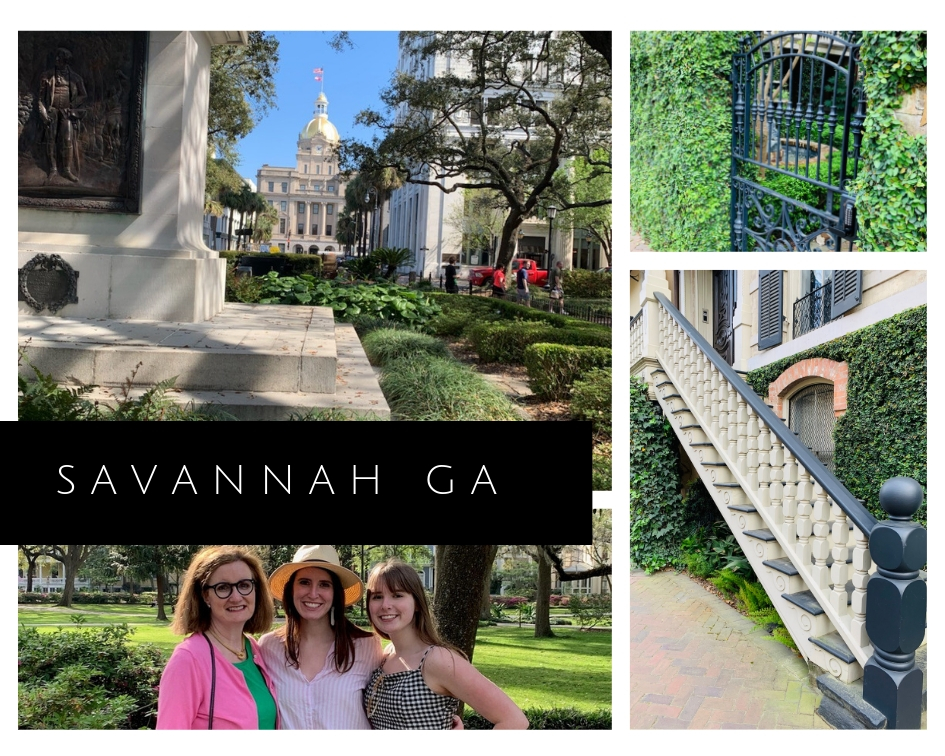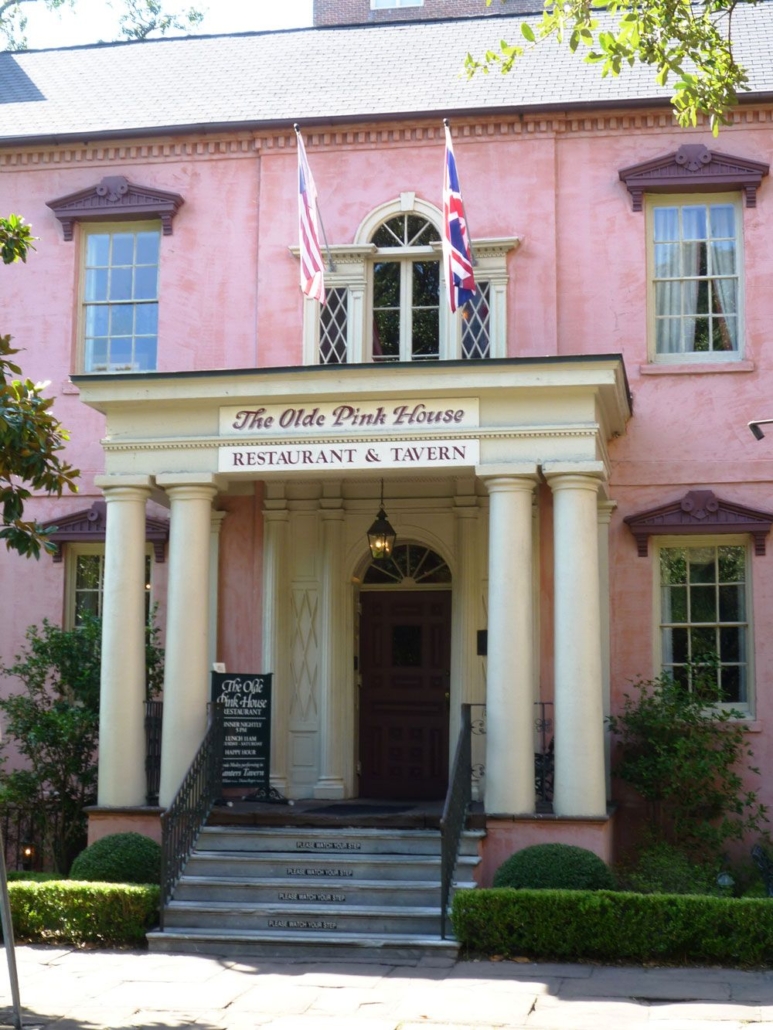Southern Charm! Exploring Savannah Architecture
 Savannah architecture is well-known for historic and design significance and we thoroughly enjoyed seeing many great examples in the Landmark Historic District. The Historic District is surprisingly large at 2 ½ miles square. Bordered by River Street, Gaston Street, East Broad Street, and Martin Luther King Jr. Boulevard, the historic district is best seen on foot. It is the nation’s largest historic district and is home to thousands of historic structures and 22 scenic squares. You’ll see examples of residential architecture in a variety of styles, including Georgian, Victorian, Federal, Greek Revival and Italianate examples. Read on to learn why a visit to Savannah should be on your bucket list!
Savannah architecture is well-known for historic and design significance and we thoroughly enjoyed seeing many great examples in the Landmark Historic District. The Historic District is surprisingly large at 2 ½ miles square. Bordered by River Street, Gaston Street, East Broad Street, and Martin Luther King Jr. Boulevard, the historic district is best seen on foot. It is the nation’s largest historic district and is home to thousands of historic structures and 22 scenic squares. You’ll see examples of residential architecture in a variety of styles, including Georgian, Victorian, Federal, Greek Revival and Italianate examples. Read on to learn why a visit to Savannah should be on your bucket list!
Tip: Look for beautiful examples of ironwork on railings, balconies, and windows.
These were created right in Savannah!
Savannah’s Brilliant City Planning
Savannah was established in 1733 on a bluff above the Savannah River by General George Oglethorpe and 114 other settlers, with the help and friendship of Chief Tomo-chi-chi and the local Creek Indians. The colony of Georgia was named by Oglethorpe after King George II. The 13th and last colony was originally established as a religious haven for all but Catholics and served as a military buffer between the northern colonies and the Spanish in Florida.
Did You Know? Savannah was the last British colony in the New World.
Savannah was America’s first planned city. The plan included a gridded system of wards, each of which contained squares, lots, and lanes.
The squares are at the center of each ward and they were (and continue to be) used for communal purposes. Squares feature beautiful fountains, sculptures, monuments, gazebos, and more. Savannah’s squares are designated as a National Historic Civil Engineering Landmark.
Double-size “trust lots” on the east and west side of each square were used for public buildings. On the north and south sides of each square, there are smaller “tithing lots” which were designated for homes. Although the original city plan called for 24 squares, only 22 were finalized.
Savannah architecture has changed over the years, due to fires, demolition, and decay, but there is still an amazing variety of lovely buildings to experience on your visit there. Click here for self-guided walking tours of Savannah, with popular points of interest.
In 1793, Eli Whitney invented the cotton gin near Savannah at Mulberry Grove plantation, which revolutionized the cotton industry. Savannah’s port grew and by 1820 they exported ninety thousand bales of cotton. Today, the Port of Savannah is a major US seaport with facilities for ocean-going vessels for 18 miles along the Savannah River.
Savannah Architecture
There are many lovely historic buildings in the Savannah Historic District, thanks to the efforts of local preservationists.
In 1955, seven women formed the Historic Savannah Foundation and raised money to purchase and resell endangered properties to save them from demolition. The Foundation continues to play a key role in saving “buildings, places, and stories that define Savannah’s past, present, and future.”
Savannah is also the home of the Savannah College of Art and Design (SCAD). The college’s 16,000 students live and go to class in mostly restored structures located in the Historic District. The college has played a huge part in saving and restoring Savannah’s historic buildings.
Here are some examples of Savannah architecture that we enjoyed the most:
- Built in 1848
- Stuccoed brick Italianate-style with intricate cast-iron railings and balconies
- Designed by architect John S. Norris
- General Robert E. Lee was a Low family friend and a frequent visitor
- Known for its fine ornamental ironwork
- Home of Juliette Gordon Low, who founded the Girl Scouts here on March 12, 1912
Cathedral of St. John the Baptist
- Built in 1900
- Brick with iron columns, groin arches, and tall spires
- Features stained glass windows built by Innsbruck Glassmakers in Austria and painted murals
- Oldest Roman Catholic church in Georgia
- Built in 1820 by master builder Isaiah Davenport
- Red brick Federal-style home with fine woodwork and plasterwork
- Threatened with demolition, neighbors bought and restored the home in 1955.
- As the first of many historic renovations in Savannah, it was the beginning of the Historic Savannah Foundation.
- Serves now as a museum and hosts a variety of programs and events, including weddings
- Built in 1861
- Built by members of the congregation, many of whom were slaves
- Features stained glass windows from Austria and installed in 1885
- The wood pews are carved with African symbols
- The oldest continuously active African-American church in North America
- A haven for runaway slaves who hid in a space between the basement and the foundation

Olde Pink House, Savannah GA
- Built in 1771
- Pink stuccoed brick Georgian-style with Greek portico with fanlight and Palladian window
- One of the few buildings to survive Savannah’s fire of 1796
- Built for James Habersham Jr., one of Savannah’s founding family members
- Repurposed for a variety of uses, including banks and the Union army headquarters, it is now a restaurant. Unfortunately, it was closed when we were in town so we have even more reason to return to Savannah.
- Built in 1819
- English Regency-style with curving walls, stained glass, and ornamental moldings
- Designed by William Jay
- Built of local materials including a tabby foundation, a combination of lime, gravel, and shells
- Includes the original slave quarters and furnishings
- The home had indoor toilets before the White House and the Palace at Versailles.
- Revolutionary War hero the Marquis de Lafayette stayed there in 1825.
Affectionately known as the “Hostess City”, Savannah hosts millions of overnight and day-trip visitors each year. Tourism continues to be one of the city’s largest economic drivers. According to the Savannah Chamber of Commerce, over 13.4 million visitors came to Savannah in 2014.
We especially enjoyed the people who were very friendly and helpful to our family during our Spring Break visit. You may want to come during one of the city’s world-class music festivals, the SCAD Savannah Film Festival or during March for the famous St. Patrick’s Day Parade. See a list of Savannah events here and order your own Visitor Guide.
Take it easy! Have a drink at one of the city’s rooftop bars and take in the views of Georgia’s Low-country. We enjoyed watching huge ocean-going container vessels navigating the Savannah River as they made their way to and from the city’s busy port. Read more about the history of Savannah here.
Because of the grid layout of Savannah’s Historic District, it is really easy for visitors to navigate, wander around and explore Savannah architecture. Everywhere you look, there are beautiful historic buildings, unique shops, and fine restaurants. In addition, coastal beach destinations and world-class golf are just a stone’s throw away. Add a temperate climate and you have a picture-perfect vacation destination!



